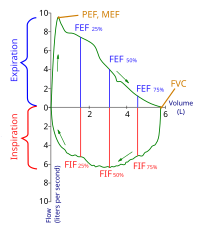
Photo from wikipedia
Respiratory muscle weakness either occurs in isolation or as part of a more generalized neuromuscular process. In the former case, this is very often self-limiting as, for example, after iatrogenic… Click to show full abstract
Respiratory muscle weakness either occurs in isolation or as part of a more generalized neuromuscular process. In the former case, this is very often self-limiting as, for example, after iatrogenic damage to the phrenic nerve or in the case of neuralgic amyotrophy. In the latter case, patients will usually have evidence of limb muscle involvement and or a known diagnosis (notable exceptions, however, being Pompe disease and about 3% of amyotrophic lateral sclerosis [ALS] presentations). From this conjecture follow the two main reasons why clinicians request evaluation of inspiratory muscle strength—either to rule in or rule out inspiratory muscle weakness as a cause of symptoms or to predict prognosis (or the need for noninvasive ventilation). Maximal inspiratory pressure (MIP) has also frequently been used as an outcome measure for trials of inspiratory muscle training.
Journal Title: Chest
Year Published: 2017
Link to full text (if available)
Share on Social Media: Sign Up to like & get
recommendations!